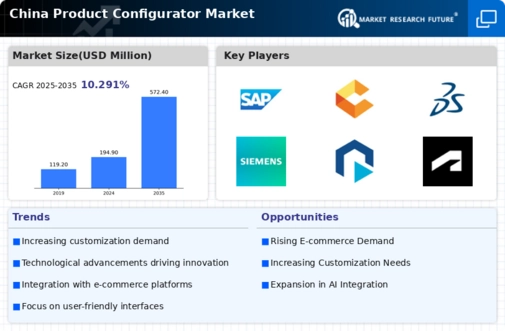Evolving Retail Landscape
The evolving retail landscape in China is reshaping the product configurator market. With the rise of omnichannel retailing, businesses are increasingly integrating online and offline experiences. This shift necessitates the implementation of product configurators that can seamlessly operate across various platforms. Retailers are recognizing that providing a consistent and engaging customer experience is crucial for driving sales. Reports indicate that 60% of consumers prefer brands that offer a unified shopping experience. As retailers adapt to this new landscape, the demand for product configurators that facilitate customization and enhance user experience is expected to grow. This evolution in retail not only influences consumer behavior but also propels the product configurator market forward.
Increased Investment in R&D
Increased investment in research and development (R&D) is a critical driver of the product configurator market in China. Companies are allocating substantial resources to innovate and enhance their configurator offerings. This focus on R&D is essential for developing advanced features that improve user experience and streamline the customization process. Data indicates that R&D spending in the technology sector is projected to grow by 15% annually, reflecting a commitment to innovation. As businesses strive to differentiate themselves in a competitive market, the development of sophisticated product configurators becomes paramount. Enhanced functionalities, such as real-time rendering and user-friendly interfaces, are likely to attract more consumers, thereby driving growth in the product configurator market.
Rising Consumer Expectations
In the product configurator market, rising consumer expectations play a pivotal role in shaping industry dynamics. As consumers in China become increasingly discerning, they demand personalized products that cater to their specific needs. This trend is reflected in the growing inclination towards customization, with a reported 70% of consumers expressing a preference for tailored solutions. Companies are thus compelled to adopt product configurators to meet these expectations, enhancing customer satisfaction and loyalty. The ability to visualize and modify products in real-time not only improves the purchasing experience but also drives sales. Consequently, businesses that leverage product configurators are likely to gain a competitive edge in the market, as they can respond more effectively to consumer demands and preferences.
Growth of the Manufacturing Sector
The growth of the manufacturing sector in China is a significant driver for the product configurator market. As the country continues to expand its industrial capabilities, manufacturers are increasingly adopting product configurators to optimize production processes. This trend is particularly evident in sectors such as automotive and electronics, where customization is paramount. Data suggests that the manufacturing sector's contribution to China's GDP is projected to reach 30% by 2026, indicating a robust environment for product configurators. By enabling manufacturers to offer customized solutions while maintaining efficiency, product configurators are becoming essential tools in the industry. This alignment with manufacturing growth is likely to bolster the product configurator market, as companies seek to enhance their operational capabilities.
Advancements in Digital Technologies
The product configurator market is significantly influenced by advancements in digital technologies. Innovations such as augmented reality (AR) and virtual reality (VR) are transforming how consumers interact with products. In China, the integration of these technologies into product configurators allows customers to visualize their customizations in a more immersive manner. Reports indicate that companies utilizing AR in their configurators have seen a 30% increase in customer engagement. Furthermore, the rise of artificial intelligence (AI) enhances the configurator experience by providing intelligent recommendations based on user preferences. As digital technologies continue to evolve, they are expected to further streamline the customization process, making it more efficient and user-friendly, thereby driving growth in the product configurator market.




















Leave a Comment